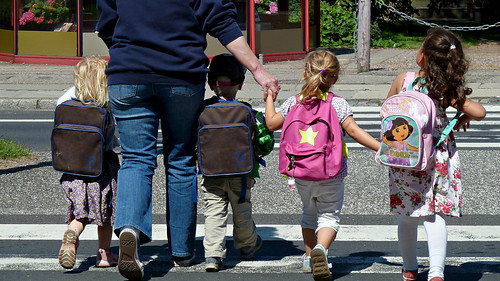Photo Credit: Comrade Foot via Flickr
It's back to school time and for many students that means it's time to get a new backpack! But did you know that heavy backpacks are a common cause of back pain in students? Today I'm going to share some tips for choosing, packing, and wearing a backpack safely.
When shopping for a new backpack, here are a few things to keep in mind:
- Go to the store and have your child try on a variety of backpacks. This will allow you to find a backpack that fits properly, with the bottom of the backpack resting in the curve of the back and the top of the backpack (where the straps meet the bag) no more than two inches below the shoulders.
- Look for a backpack that rests against your child's back with little movement.
- Sturdy, padded shoulder straps will provide comfort when wearing the backpack.
- A waist strap will help redistribute the weight of the backpack to the hips.
- Take into consideration your child's organizational style. A visual organizer may prefer a backpack that allows them to see all items at one time; a spatial/cozy organizer will want the backpack to feel just right; and a chronological/sequential organizer may want a backpack that contains many pockets and dividers.
Tips for packing a backpack:
- When filled, a student's backpack should weigh no more than 10% of the student's body weight. For a 70 pound student, that means the backpack should weigh no more than 7 pounds.
- When packing the backpack, make sure the largest, heaviest items are packed closest to the body.
- Unpack the backpack each day and remove items that don't need to be in the backpack.
- Limit the number of items that are carried to and from school each day by leaving unused items at school or at home.
- If the backpack is too heavy, consider taking out a heavy item and carrying it by hand. For example, a student could carry his lunchbox or water bottle, rather than placing it inside the backpack.
Tips for wearing a backpack:
- Always wear the backpack with both straps and make sure each strap is adjusted to the same length.
- If the backpack contains a waist belt, make sure it is securely fastened to decrease movement of the backpack and to redistribute the weight of the backpack.
- Don't wear the backpack too low! Adjust the shoulder straps so the bottom of the backpack hits the lower back and the top of the backpack hits two inches below the shoulders.
A few alternatives to traditional backpacks:
- A backpack on wheels can be a nice alternative for students who need to carry around heavier items.
- A rolling backpack can also be beneficial for students with special needs who have difficulty getting their backpack on and off throughout the day, or who cannot safely walk while carrying a backpack.
- Large zipper pulls can make managing the zipper easier for students with fine motor delays.
For more information on backpack safety, visit AOTA's website for Backpack Facts and Backpack Strategies.

No comments:
Post a Comment